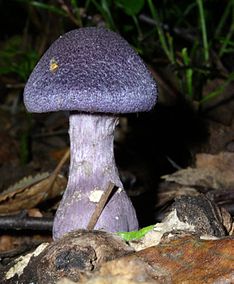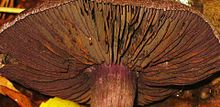- Cortinarius violaceus
-
Cortinarius violaceus 
Scientific classification Kingdom: Fungi Division: Basidiomycota Class: Agaricomycetes Subclass: Homobasidiomycetidae Order: Agaricales Family: Cortinariaceae Genus: Cortinarius Subgenus: Cortinarius Species: C. violaceus Binomial name Cortinarius violaceus
(L.: Fr.) GrayCortinarius violaceus Mycological characteristics 
gills on hymenium 
cap is convex 
hymenium is adnate 
stipe is bare 
spore print is reddish-brown 
ecology is mycorrhizal 
edibility: edible Cortinarius violaceus is a mushroom in the genus Cortinarius. It is the type species of the genus, but is distinguished from other species due to its dark colouration and distinct cystidia. Though edible, its primary appeal is its appearance, as it is the darkest mushroom in the genus, comparable only with members of other genera.
Contents
Taxonomy
Agaricus violaceus was one of the few fungal species named by Carl Linnaeus, the "father of taxonomy". It was subsequently combined in Cortinarius by Samuel Frederick Gray.[1] The specific epithet violaceus refers to the deep violet colour of its cap.[2] In English, it is sometimes known as the Violet Webcap.[3]
Cortinarius violaceus is the type species for the genus Cortinarius, which David Arora considers odd due to its atypical colour and cystidia. However, if it were to be split from the genus, then, according to the rules of the International Code of Botanical Nomenclature, it would retain the name Cortinarius, while the other species would have to be reclassified.[4] However, the species was one of only two species placed in the Cortinarius subgenus Cortinarius by the Austrian mycologist Meinhard Moser.[5]
Description
Cortinarius violaceus has a convex (becoming broadly convex, umbonate or flat[4]) cap of 3.5 to 15 centimetres (1.4 to 5.9 in) across with an incurved margin.[5] In colour, it is a dark violet to blue-black, and is covered in fine, downy scales. The stem is 6 to 12 centimetres (2.4 to 4.7 in) tall, while 1 to 2 centimetres (0.39 to 0.79 in) thick. Due to its swollen, bulbous nature, the base of the stem can sometimes be as wide as 4 centimetres (1.6 in) thick. The stem is a similar colour to the cap, and covered in woolly fibrils.[5] Younger specimens feature a veil, but this vanishes quickly.[4] The flesh is violet, but darker below the cap's cuticle and in the stem.[5] The gills are dark violet, changing to a purplish-brown with age.[5] The species is the only one in the genus to have cystidia on both the faces and the edges of the gills. In shape, the gills are adnate, becoming adnexed, and are fairly well-spaced.[4]
The spore print is rust-coloured, while the spores themselves measure 12 to 15 micrometres (0.00047 to 0.00059 in) by 7 to 8.5 micrometres (0.00028 to 0.00033 in), and are rough, shaped from elliptically to almond-shaped.[5]
Some mycologists classify C. violaceus as two distinct species- Cortinarius violaceus, and Cortinarius hercynicus,[6] differentiated due to the latter's rounder spores.[4]
Of the many violet-coloured Cortinarius species, C. violaceus is the most deeply coloured. It is sometimes so dark that it is almost black, making it difficult to notice in woodland. The only other mushrooms with a comparable colour are certain Leptonia species, including L. carnea and L. nigroviolacea. The Leptonia species are easily differentiated due to their pink spore print.[4]
Edibility and other uses
The flesh of C. violaceus has a mild taste, with a slight smell reminiscent of cedar-wood.[5] It is considered edible, but is not choice; instead, its primary appeal, according to Arora, is its beauty.[4] The taste after cooking is reportedly bitter.[2] Though some Cortinarius species (such as C. sanguineus and C. semisanguineus) can be used to make dyes, C. violaceus, despite its dark colour, is not one of them.[4]
Distribution and habitat
Cortinarius violaceus is found in North America, Europe, Central America,[7] Japan,[8] Australia,[9] and New Zealand.[10][11] It is an uncommon species, found in Europe in deciduous woodland during autumn, especially among oak, birch and beech, but is also found on occasion with conifers.[5] In North America, it favours conifers, and, though rare over much of the continent, is relatively common in certain areas including Mount Rainier National Park and Olympic National Park.[4] Fruit bodies occur solitarily or in small groups, often near rotting wood.[4]
See also
References
- ^ Index Fungorum - Search Page
- ^ a b Weber, Nancy S.; Smith, Alexander Hanchett (1980). The Mushroom Hunter's Field Guide. Ann Arbor, Mich: University of Michigan Press. pp. 202–203. ISBN 0-472-85610-3. http://books.google.co.uk/books?id=TYI4f6fqrfkC&pg=RA5-PA203&dq=%22Cortinarius+violaceus%22&lr=lang_en&as_brr=3&as_pt=ALLTYPES&client=firefox-a#PRA5-PA202,M1. Retrieved 8 March 2009.
- ^ Phillips, Roger. "Cortinarius violaceus". RogersMushrooms. http://www.rogersmushrooms.com/gallery/DisplayBlock~bid~5470~gid~.asp. Retrieved 8 March 2009.
- ^ a b c d e f g h i j Arora, David (1986). Mushrooms Demystified. Berkeley, California: Ten Speed Press. ISBN 0-89815-169-4. http://books.google.co.uk/books?id=vY8FXXrlHFMC&pg=PA446&dq=%22Cortinarius+violaceus%22&lr=lang_en&as_brr=3&as_pt=ALLTYPES&client=firefox-a. Retrieved 8 March 2009.
- ^ a b c d e f g h Phillips, Roger (1981). Mushrooms and Other Fungi of Great Britain and Europe. London: Pan Books. p. 133. ISBN 0330264419.
- ^ Hercynicus, "of the Hercynian Forest region".
- ^ http://www.nybg.org/bsci/res/hall/cortviol.html (with photo)
- ^ http://fungi.sakura.ne.jp/ajiwai_kinoko/murasakihuusentake.htm (with photo)
- ^ http://www.blueswami.com/cortinarius_violaceus.html (with photo)
- ^ New Zealand Fungi - Cortinarius violaceus
- ^ http://es.mirror.gbif.org/occurrences/searchCountries.htm?c[0].s=20&c[0].p=0&c[0].o=14377489
External links
 Media related to Cortinarius violaceus at Wikimedia CommonsCategories:
Media related to Cortinarius violaceus at Wikimedia CommonsCategories:- Cortinariaceae
- Edible fungi
- Fungi of North America
- Fungi of Europe
- Fungi of Australia
- Fungi of New Zealand
Wikimedia Foundation. 2010.

